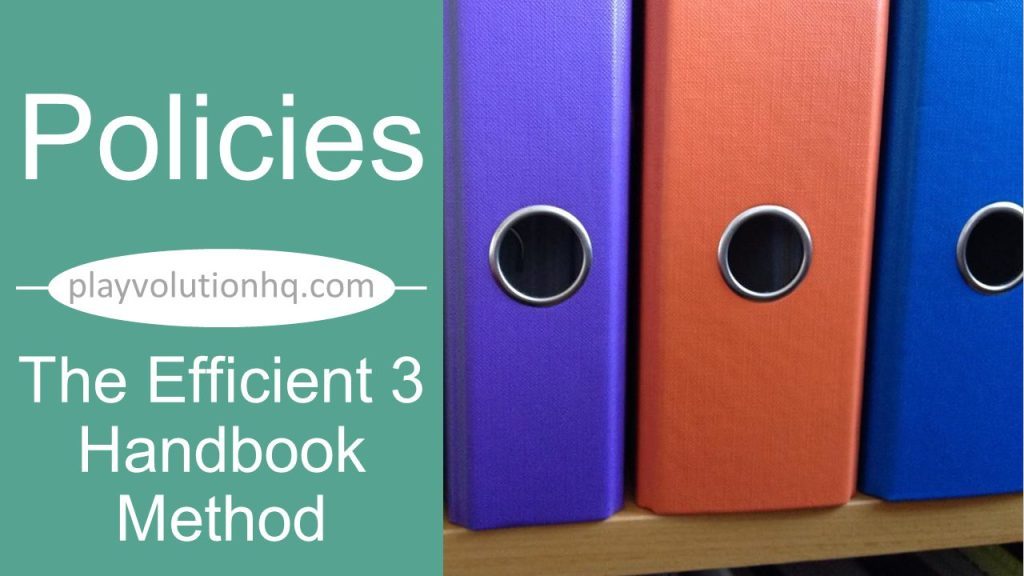
Overview
The efficient 3 Handbook Method is the most effective solution for efficiently sharing early learning policies and procedures with the people who need them.
Over the last thirty years, I’ve invested wasted hours days contemplating the optimal number of program handbooks a child care or preschool program requires in order to most effectively organize and share polices and procedures. (That tells you all you need to know about what a wild and crazy guy I am, right?)
The answer, as you probably guessed from the title of this post, is 3.
First, we’ll take a gander at the 3 Handbook Method and then a look at why it is the ideal option for organizing and sharing early learning policies and procedures.
The Efficient 3 Handbook Method
With this method, each policy and procedure will reside in one of these three handbooks:
Parent Handbook
This document contains only policies and procedures relevant to parents. Things like emergency contact requirements, tuition and fees, when to keep a child home sick, etc. Parents all receive a copy of this document when their child is enrolled and whenever an update is made. Staff members don’t need their own copies of this document, but one should be accessible to them in case a parent has a question.
Staff Handbook
This document contains only staff-specific policies and procedures. Things like how staff vacation days work, staff training requirements, how to take a sick day, etc. Staff members all receive their own copies of this document when hired and whenever it is updated. There’s probably nothing of interest to parents in this document.
Operating Handbook
This document contains all policies and procedures both pertaining to both parents and staff members. Along with the program’s mission and philosophy, this handbook contains things like how the program deals with biting, how tornado drills are conducted, the program’s rough and tumble play policy, what items kids can bring from home, etc. Both parents and staff members receive a copy of this document when they join the program and whenever it is updated. This will likely be the largest of the three documents.
That’s the 3 Handbook Method. Simple.
Next, some thoughts on why this method is a good option.
Policies And Procedures Become More User Friendly
Policies and procedures are meant to be read, referenced, and followed. If you want those things to happen, how you package and share them matters. Policies and procedures are next to useless if users can’t easily access the information required when it is needed.
Say that Alix, new to the toddler room staff, needs to know the diaper changing protocol, or how she’s supposed to deal with biting, or when she gets to take a break. Her job is much more difficult when she can’t find clear answers and therefore doesn’t know what’s expected of her.
Similarly, life is easier for Peiter, when he can easily find out if it is OK for Onan, his four-year-old, to bring the toy laser blaster grandma just got him to preschool.
Programs experience less interpersonal friction when everyone knows what’s expected of them and how to do those things. There will always be friction, but most people are thrilled to have a little less of it in their lives. The 3 Handbook Method reduces friction.
No Extra Information
The 3 handbook method also only provides people the information they need. Alix, Peiter, and everyone else should have the info they require when it is useful–but you shouldn’t weigh them down with irrelevant policies and procedures. For one thing, this wastes time, attention, and energy by forcing them to hunt through the unnecessary to locate the necessary.
Reduced Repetition
The 3 Handbook Method also reduces repetition, making policy and procedure edits and updates easier. With other methods, a policy may appear in multiple handbooks. That means someone has to remember where it appears and make sure it is updated in each location when the policy changes. This can cause problems. If the child arrival and departure procedures are changed in the staff handbook and not the parent handbook, for example, there will be some confusion and chaos.
With the 3 Handbook Method, each policy and procedure lives in one place–resulting in no repetition, no missed updates, and no confusion.
Keeping It Simple
Having three handbooks to keep up to date may sound like more work, but it simplifies things. With this setup, you never need to update more than one document. If the program’s fees change, you update the Parent Handbook. If your policy on staff cell phone use changes, you update the Staff Handbook. If you revise your rough and tumble play policy, you update the Operating Handbook. With all the communal information located in the Operating Handbook, you no longer need to update two documents when something changes.
The 3 Handbook Method Handout
Here’s a free PDF handout describing the method if you’d like it as a reference tool:
Related Policy And Procedure Forms And Handouts


Contribute content to Playvolution HQ
Brought to you by Explorations Early Learning
Post Author
Jeff Johnson is an early learning trainer, podcaster, and author who founded Explorations Early Learning, Playvolution HQ, and Play Haven.

Leave a Reply